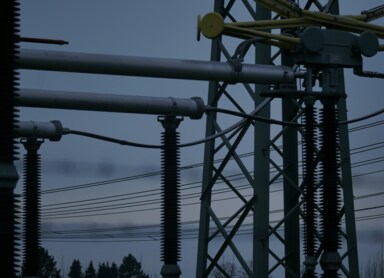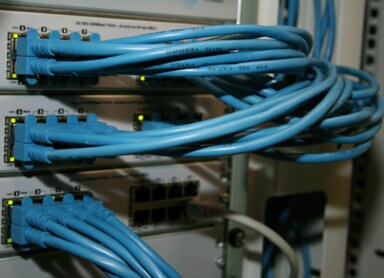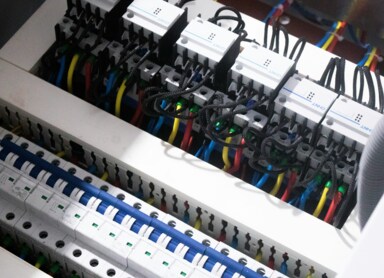What is Reactive Power Compensation? Explained!
In today’s economic reality, every kilowatt-hour counts — both for businesses and households. Reactive power, although not immediately visible, can present a significant challenge to the efficiency of power systems. How can reactive power compensation help? Why is it worth addressing? And what benefits can it bring to energy management?
Reactive Power Compensation – Definition and Importance
Reactive power compensation is a technical process aimed at improving the energy efficiency of power systems by reducing or eliminating reactive power in the grid. Although reactive power does not perform direct useful work, it is essential for the proper functioning of many electrical devices, such as motors and transformers. However, an excess of reactive power can burden the power infrastructure, cause energy losses, and consequently increase operational costs.
Controlling reactive power is crucial, as its excess significantly reduces the efficiency and performance of the entire network, leading to a low power factor. A low power factor can result in additional financial penalties. Therefore, reactive power compensation is not only a technical necessity but also a key element of strategic energy management.
Reactive Power Compensation – Basic Concepts
To fully understand the process of reactive power compensation, it’s worth becoming familiar with a few key terms. Reactive power refers to the portion of electric power needed to create a magnetic field in devices like motors, transformers, and lighting systems. It is not used to perform useful work (such as powering machines or heating).
However, it has a significant impact on the efficiency of power systems — an appropriate power factor ensures the proper functioning of the entire grid. In addition to reactive power, there are two other types of power in power systems: active power (measured in watts), which does the actual work, and apparent power (measured in volt-amperes), which is the geometric sum of active and reactive power and represents the total power delivered to consumers.
Active, reactive, and apparent power are interconnected, forming what is called the power triangle. To ensure the system operates efficiently, it is crucial to minimize reactive power, which can be achieved through compensation.
Reactive Power Compensation – Process and Methods
Reactive power compensation balances the reactive power generated by electrical consumers. In practice, this means using devices that generate reactive power with an opposite character (inductive or capacitive) to that in the network. By using these devices, it is possible to reduce the load on the grid and improve its efficiency and stability. As a result, the total reactive power in the system decreases, which relieves the power grid and enhances the efficiency and stability of the entire system.
There are several methods of reactive power compensation. In local compensation, compensating devices are installed directly at the reactive power consumers. Capacitors are most commonly used to compensate for inductive reactive power. This method reduces the flow of reactive power further down the network, significantly minimizing energy losses.
Group compensation is used for multiple groups of devices connected to a common power supply system. Devices such as capacitor banks are installed in electrical switchboards to serve the entire group simultaneously. This is an effective, though less precise, method compared to local compensation.
For large industrial installations, central compensation is applied, using compensating devices like reactors or advanced dynamic compensation systems installed at main power supply points. This allows reactive power management across the entire facility’s network.
Dynamic compensation is particularly useful in systems with variable loads. This modern method enables rapid and precise adjustment to changing network conditions using devices such as Static VAR Generators (SVGs) or Static VAR Compensators (SVCs).
Benefits and Applications of Reactive Power Compensation
Reactive power compensation is not only a technical solution for improving electrical network operation but also an essential cost optimization tool. It significantly reduces energy losses in transmission lines — by balancing reactive power, the current flowing through the network is lower, which decreases the heating of wires and other system components. Another reason for implementing compensation is the reduction of additional charges imposed by operators for excessive reactive power.
This is achieved by improving the power factor (cosφ) — the closer cosφ is to 1, the more energy delivered to the system is converted into useful work. Reactive power compensation raises the power factor, which is not only beneficial technically but often required by regulations and standards.
The application of reactive power compensation also relieves the power grid, reducing the strain on various system elements, lowering maintenance costs, and extending equipment lifespan. It helps maintain stable voltage in the network, which is particularly important in industrial plants where even minor fluctuations can lead to failures or damage, and it optimizes the operation of electrical devices.
Reactive power compensation contributes to more efficient energy use, lower operational costs, and improved durability of electrical equipment. It is applied across various industries, energy sectors, and even households.
Examples of Reactive Power Compensation in Practice
Reactive power compensation is widely used in industrial plants with numerous inductive devices, such as electric motors that generate large amounts of reactive power. Implementing compensation significantly improves the system's energy efficiency and reduces operating costs. It is also successfully used in office buildings and commercial properties, where systems like air conditioning, LED lighting, and elevators operate — compensation helps reduce network load.
In renewable energy systems, reactive power compensation ensures stable system operation and compliance with grid operator requirements. Grid stability is also crucial in other areas — such as electric railway systems or public transport like trams and subways. In modern households equipped with many electrical appliances, local compensation can help minimize energy losses.
Reactive power compensation is a universal solution used across sectors — from industry to transportation and renewable energy. With properly selected compensation systems, it is possible to reduce energy costs, improve efficiency, and extend the lifespan of electrical equipment.






